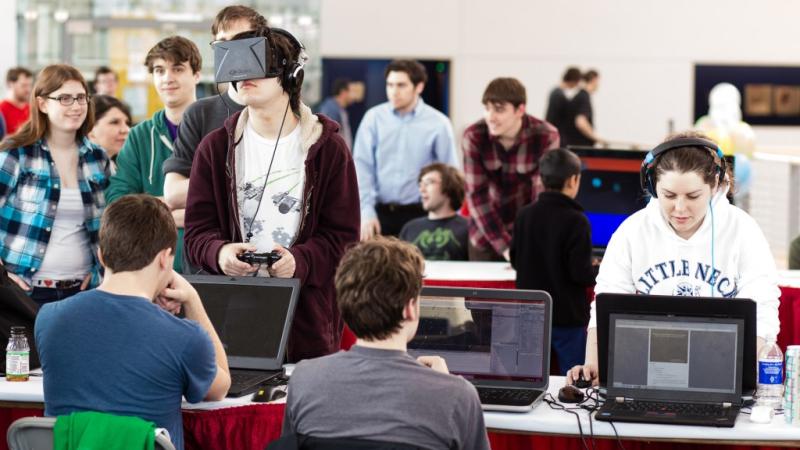April 29, 2014

Student game designers from Rensselaer Polytechnic Institute and other schools including Champlain College and Rochester Institute of Technology gathered at EMPAC Saturday to showcase a vast array of video games they had designed at the 10th annual GameFest.
This was my first GameFest and I was so impressed by the sheer number of games on display and the quick pitches I heard from students. Read a little more about students participating in GameFest in this Times Union article.
The GameFest competition was judged by professional video game developers from Vicarious Visions, a firm co-founded by RPI grad Karthik Bala '97 and based in Menands. Here's the full list of winners:
First place: Hangeki, designed by RPI students Damian Cross, Natalie Johnson, Jaron Kong, Jota San, Terence Tolman, and Greg Weil. A description of the game: "The world is under siege by waves of alien invaders. Using their advanced spacecraft to dominate the air, Yokuna Donaku and his nine generals send an endless horde to conquer mankind. Only the Hangeki, an experimental weapon of untold power, has the strength to punch through the invasion force and take the fight back to the alien homeworld. Are you ready for this fast paced take on the classic arcade space shooter?"
Second place: Kaleidoscope, designed by NYU Game Center students Aaron Freedman, Diego Garcia, and Toni Pizza. A description: "A captain and her crew have been stranded, shipless, in deep space. Faced with the knowledge that they’ve no way to get home and are doomed to die, the ship’s staff resolves to leave no member to experience their last moments alone in the void."
Third place: Gemini, designed by NYU Game Center students Atlas Chen, Nick Zhang, Kevin Chen, and Tony Yan. A description: "Gemini is a game aiming to create a meaningful emotional relationship between the player and a non-player character, through a story of two stars flying to heaven from earth by elevating each other."
Excellence in Art Direction: SunBots, designed by Champlain College's Desiree Fernandes, Melissa Gill, Matthew Jordan, Chris Mastenbrook, Liznel Piña, Ryan Steinmetz, Matt Surdej, and Remy Vogler. A description: "SunBots is a mobile platformer in which the player uses gravity-based jumps and boosts to navigate solar systems. The player needs to collect sun shards in order to restore dying suns. As the suns revive, life is brought back to the surrounding planets and expands the area for exploration."
Excellence in Design: Gravity's Pull, designed by RPI's Chris DeBartolomeo, Kevin Hendricks, Michael Lechner, and Jeffrey Steel.
Excellence in Multi-Player: Field-1, designed by NYU Game Center students Aaron Freedman, Shervin Ghazazani, Maxim Kolbowski-Frampton, and Dylan McKenzie. A description: "Field-1 is an arcade game that’s accessible and exciting for both players and spectators. It’s Frogger with your friends, it’s Hokra without the puck, and it’s the most fun you’ve had with a controller in a long time."
Excellence in Puzzle Innovation: Soft Body, designed by NYU Game Center student Zeke Virant. A description: "Soft Body is a free-roaming bullet hell game set in an abstract visual world with painting and dodging as the core mechanics. All of the game’s mechanics, sounds, and rules have been designed to feature the fluid control and look of the player’s worm-like avatar. Unlike most bullet hell or traditional space shooter games, Soft Body allows the player to move fast in every direction. Instead of a constant scrolling screen and scripted enemy encounters, the player chooses how to approach each enemy and obstacle."
Excellence in Sensory Experience: A.V., designed by R.I.T.'s Preston Johnson, Doug Lynn, Amanda Rivet, Brockton Roth, Gary "Jake" Wilson, Hunter Baule, Keith Scotland, Matt Vliet, and Nicholas Miclette. A description: "A.V. is a first-person stealth-puzzle game for the PC, developed in the Unity engine. The game places the player in the role of a rogue music-processing algorithm from a computer’s sound systems. From this role, the player can view the world only through audible means. When idle, the player views the game world as only a plain, black void. However, each sound in the game sends out a pulse of energy, illuminating a small portion of the world around that sound’s source. Through this function, players can visualize their surroundings and learn to navigate through a strange and complex computer world."
Audience Choice -- Best in Show: Head in the Clouds, designed by RPI's Nicholas Cesare, Nicholas Lewis, Ashley Tanski, and Anthony Szymcyzk.
Audience Choice -- Most Innovative: Lead with your Face, designed by RPI's James McCarthy, James Ross, Dan Newton, and Tiffany Entwistle. A description: "Lead With Your Face is an Oculus Rift sandbox game. You play as a mental patient in a straight jacket who finds he has developed telekinesis to compensate for his inability to use his arms. The game is based around the possibility of using your face as a controller (using the Oculus Rift). In the game you paint with your face, play chess with your face, drink water with you face, and lead with your face!"
Photographer Kevin Chen got some great images from the event:








